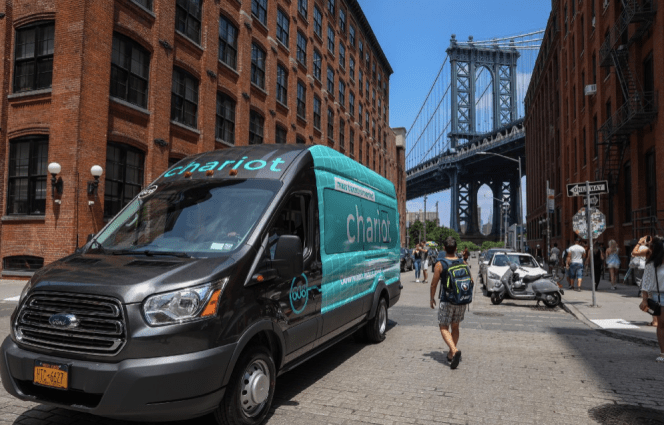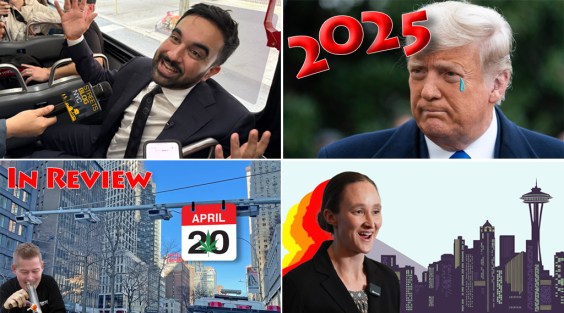To hear the start-up world tell it, "micro transit" is the next big urban transportation breakthrough. But out in the real world, the results haven't lived up to the hype.
"Micro transit" refers to services that function like UberPool or LyftLine but with large vans or minibuses instead of sedans and SUVs, using mobile apps and algorithms to match passengers making similar trips in a single vehicle. The pitch to public agencies is that micro transit can be a more cost-effective way to provide service in some travel markets than fixed-route buses.
Years after micro transit started grabbing attention -- CityLab reported on the crowded start-up scene back in 2015 -- we're still waiting for the first significant success story. Despite a string of failures, a growing number of transit agencies are contracting with firms like Via and Transloc to give micro transit a try, and the press coverage remains credulous, almost fawning.
Four agencies in California recently embarked on micro transit pilots. Transloc, now a subsidiary of Ford, called 2017 a "banner year" and projected a 600 percent increase in "live pilots" in 2018. Nationwide, at least 24 transit agencies are expected to initiate micro transit contracts this year, according to the Washington Post, which said micro transit "might be an answer" for transit agencies losing riders.
Micro transit may have a place in city transportation systems, but experience so far suggests that it's a very small niche, like an app-enabled version of dial-a-ride service. The PR for micro transit is outrunning empirical experience. It is clearly not the large-scale substitute for bus service that much media coverage makes it out to be.
An early experiment with the now-bankrupt Bridj in Kansas City was a complete flop. Riders made only 1,480 trips during the course of the one-year pilot, even though each passenger got their first 10 rides for free. Only a third of riders kept using the service after the free rides expired. The local transit agency, KCATA, spent $1.5 million to administer the service, for a jaw-dropping subsidy of more than $1,000 per ride.
The Santa Clara Valley Transportation Authority, serving San Jose and its suburbs, began a micro transit experiment in 2015. Again, the results were woeful. EnoTrans reports that it generated only 0.4 boardings per hour that a vehicle was in service, a tiny fraction of the 15-boardings-per-hour threshold that VTA requires to keep running bus routes. The core ridership of the micro transit service consisted of just 20 people, according to EnoTrans.
Maybe what happened in Kansas City and Santa Clara was a learning experience and not indicative of broader limitations with micro transit. The start-ups in the industry are certainly banking on transit agencies seeing it that way. They are aggressively pursuing contracts for pilots, especially with agencies near Silicon Valley.
Recently, AC Transit, serving the East Bay, contracted with DemandTrans to provide low-density suburban areas with "flex rides" that allow people to book trips on demand from pick-up locations at certain bus stops. The micro transit service replaced some fixed route service, using DemandTrans software to match people and vehicles. So how'd it perform? Not too well.
The flex rides served just three passengers per hour, reported AC Transit planner John Urgo in a post for TransitCenter, "less than half of the fixed route it replaced":
There’s no getting around the fact that on-demand transit carries fewer passengers per hour than even a low ridership fixed route. This makes it hard to justify as a replacement service, especially on a route for route basis.
Greg Rogers, formerly a policy analyst at EnoTrans, recently put out a call on Twitter for any examples of successful micro transit experiments, saying that "so far microtransit pilots have experienced mixed results -- and in some cases, absolute failures." Nobody who responded could point to an unmitigated success.
But Transloc replied that it had improved "riders per hour" for the Sacramento Regional Transit. Sacramento and Transloc have been loudly touting the "success" of this micro transit pilot.
Transloc CEO Doug Kaufman told Mobility Lab, “SacRT’s success in deploying innovative, on-demand microtransit is a proof-point for the huge potential impact of microtransit across the nation, particularly for riders." But the numbers don't bear that out.
Sacramento Regional Transit had been operating an on-demand service where riders called in advance and were picked up at their home in the low-density suburb of Citrus Heights. These types of point-to-point services are inherently less efficient than fixed-route transit and should be that much easier for micro transit firms to outperform.
Prior to TransLoc's involvement, Sacramento's "Dial-a-Ride" served around two people per hour, according to SacRT's Forward Network Plan [PDF]. The report, released in April, notes that "early results of SacRT’s 'microtransit' pilot" -- the one with Transloc -- "suggest that it will not exceed 3 boardings per hour." About the same.
In other words, as of April, there was no evidence that TransLoc was outperforming the dial-a-ride service it replaced. (Streetsblog requested up-to-date numbers from SacRT and did not receive a response.) Nevertheless, in May the Sacramento Transportation Authority awarded SacRT a $12 million grant to expand the service.
Diverting resources to micro transit that could be devoted to fixed-route bus service may accelerate the downward trend in transit ridership in American cities, a scenario that TransitCenter and transit analyst Jarrett Walker have been warning about.
As Walker writes, "micro transit" does little besides package dial-a-ride-type services in an app. The interface may be convenient, but it can't overcome the geometric efficiency of fixed-route service. To pretend otherwise will make transit service less equitable.
"On average, microtransit seems to trigger an upward redistribution of the benefits of public subsidy," Walker writes. "This is a Very Bad Thing for the public sector."
Correction: The original report said Sacramento's "dial-a-ride" received 6 boardings per hour. Six is the upper limit on dial-a-ride services generally, not in Sacramento. In Sacramento, the number is closer to two -- about the same as the service that replaced it. Our apologies.
SaveSave
SaveSave






